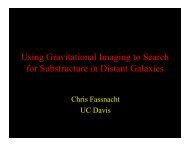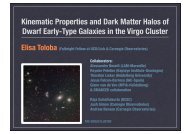DPS 42nd Meeting Abs..
DPS 42nd Meeting Abs..
DPS 42nd Meeting Abs..
- No tags were found...
You also want an ePaper? Increase the reach of your titles
YUMPU automatically turns print PDFs into web optimized ePapers that Google loves.
Presentaon Time: 10/4/2010 4:36 PM - 4:38 PMLocaon: Exhibit Hall<strong>Abs</strong>tract: Our research program comprises the measurement and modeling of ultraviolet molecular photoabsorpon cross secons with the highest praccalresoluon. Measurement and modeling efforts on molecular nitrogen, sulfur dioxide, diatomic sulfur, and carbon dioxide are in progress.N 2 : We measure line f-values and widths within the complex spectrum between 80 and 100 nm. Our measurements are incorporated into a theorecal model ofthe absorpon spectrum of N 2 which has established the mechanisms responsible for predissociaon and reproduces the observed features in all N 2 isotopomersas a funcon of temperature.SO 2 : We provide astronomers with high-resoluon cross secon data for the complex ultraviolet SO 2 absorpon spectrum. Using the Imperial College VUV Fouriertransform spectrometer, we have completed and published cross secons from 198 to 325 nm (295 K) and from 199 to 220 nm (160 K). We have completed workon further low-temperature measurements from 220 to 325 nm.S 2 : Interpretaons of atmospheric (Io, Jupiter) S 2 absorpon features are hindered by a complete lack of laboratory cross secons in the ultraviolet. We havebegun to quanfy the photoabsorpon spectrum of S 2 from 200 to 300 nm. We have designed an experimental apparatus to produce a stable column of S 2 vapor.Measurements of S 2 absorpon features at high resoluon will be complemented by coupled-channel calculaons of the relevant transions.CO 2 : The photodissociaon of CO 2 is a fundamental photochemical process in the atmospheres of Mars and Venus. Our research centers on the measurement ofhigh resoluon cross secons from 87 to 120 nm. We have completed measurements at 295 K and 195 K over the 106 to 120 nm region. We have recentlycompleted preliminary room temperature measurements in the 87 to 106 nm region.We acknowledge grant support from NASA (NNX08AE78G), STFC-PPARC, and ARC (DP0558962).48.10: High Resoluon Fluorescence Spectrometry: The N2 and N I EmissionsAuthor Block: C. Y. Robert Wu 1 , J. I. Lo 2 , Y. C. Lin 2 , H. S. Fung 3 , Y. Y. Lee 3 , T. S. Yih 2 , D. L. Judge 11 Univ. of Southern California, 2 Naonal Central University, Taiwan, 3 Naonal Synchrotron Radiaon Research Center, Taiwan.Presentaon Time: 10/4/2010 4:38 PM - 4:40 PMLocaon: Exhibit Hall<strong>Abs</strong>tract: Our goal is to invesgate the complicated interacons among the excited electronic states of N2. In addion to high resoluon absorpon crosssecon measurements we have studied the J-dependent predissociaon rates, cascade transions and their branching raos for several excited states of N2 atdifferent pressure and temperature condions. Dispersed fluorescence spectra (DFS) and fluorescence excitaon spectra (FES) produced through photoexcitaonof N2 using synchrotron radiaon in the extreme ultraviolet region have been obtained. An ultrahigh resoluon (0.0014 nm) spectrometer has been ulized toobtain a rotaonally resolved FES experiment in spectral region between 80 and 100 nm. In the DFS experiments we have employed a 0.5-m and a 0.2-mspectrometer coupled with a posion-sensive-array detector to study the fluorescence spectra. Furthermore, we have also measured the fluorescence crosssecons of several NI lines produced through photoexcitaon of N2 in the 70-80 nm region.We are currently carrying out the above N2 experiments at temperatures as low as 77 K so that the data can be applicable to the characterizaon of the N2emissions in the atmospheres of Titan and Pluto. Detailed results will be presented. This research is based on work supported by NSF grant AST-0906158.48.11: The Microwave Properes of Jovian Clouds: Laboratory Measurement of Aqueous Ammonia (N H4OH) Between 2-8.5 GHzAuthor Block: Danny Duong 1 , P. G. Steffes 11 Georgia Instute of Technology.Presentaon Time: 10/4/2010 4:40 PM - 4:42 PMLocaon: Exhibit Hall<strong>Abs</strong>tract: Laboratory measurements of the complex dielectric properes of aqueous ammonia, under condions characterisc of Jovian clouds, have beenmade in the 2-8.5 GHz range at temperatures ranging from 24-60 oC and concentraons of 0-8.5% ammonia (NH3) by volume. No previous laboratory experimentshave been made to characterize the microwave dielectric properes of aqueous ammonia. Previous models of Jovian microwave emission (de Pater et al., Icarus,2005) have assumed that for low concentraons of ammonia in soluon, the dielectric properes of aqueous ammonia are approximately equal to those of water;however, these measurements suggest that even at concentraons as low as 0.5% NH3 by volume, there is a marked difference in the complex dielectricproperes of aqueous ammonia. Assuming Raleigh scaering, these measurements are applied to a cloud aenuaon model to calculate the opacity of theJovian aqueous ammonia clouds. These measurements will improve our understanding of the data collected by the Juno microwave radiometer (MWR) bycharacterizing the absorpon properes of the aqueous ammonia present in the Jovian atmosphere.This work was supported by NASA Contract NNM06AA75C from the Marshall Space Flight Center supporng the Juno Mission Science Team, under Subcontract699054X from the South-west Research Instute.48.12: W ITHDRAW N: Laboratory Pressure Broadening Coefficients To Support SOIR/VEx And SOIR-N OMADAuthor Block: Rachel Drummond 1 , T. Földes 2 , J. Vander Auwera 2 , A. Mahieux 1 , S. Robert 1 , A. Vandaele 1 , V. Wilquet 11 Belgian Instute of Space Aeronomy, Belgium, 2 Université Libre de Bruxelles, Belgium.Presentaon Time: 10/4/2010 4:42 PM - 4:44 PMLocaon: Exhibit Hall<strong>Abs</strong>tract: Precise spectroscopic data to describe CO 2 pressure-broadened lineshapes of trace gases in the Venus and Mars atmospheres are rather scarce. Inan aempt to compensate for such a situaon, we recorded in the laboratory CO 2 broadened absorpon spectra of the 1-0 band of HCl near 2886 cm -1 and the ν 3band of CH 4 near 3019 cm -1 at several pressures between 150 and 700 Torr, using a high-resoluon Fourier transform spectrometer. CO 2 pressure broadeninghalf-width coefficients are extracted by least-squares fing of suitable molecular line profiles, including instrumental effects.Sensivity studies have been performed using the characteriscs of the SOIR instrument. This instrument is currently on board the Venus Express mission (ESA)and has been proposed as payload for the future ExoMars 2016 TGO mission (ESA/NASA).The SOIR instrument is designed to measure atmospheric transmission in the near-IR (2.2 - 4.3 µm) at high resoluon (0.12 cm -1 ) through solar occultaonobservaons. It therefore allows the derivaon of unique remote sensing informaon about the vercal structure and composion of the Venus mesosphere, withvery good spaal resoluon.At Venus, SOIR is able to provide HCl vercal profiles ranging typically from 80 to 105 km, at both morning and evening terminators, where the dynamics of theplanetary atmosphere are relavely unknown. At Mars, the high resoluon of the instrument will make it possible to observe CH 4 , if any.We show here how these two approaches, laboratory and space missions, are complimentary, as broadening coefficients measured in the laboratory allow us tosimulate perfectly HCl and CH 4 lines as seen by SOIR.48.13: Crical Evaluaon of the Photoabsorpon Cross Secon of CO 2 from 0.125 to 201.6 nm at Room Temperature





